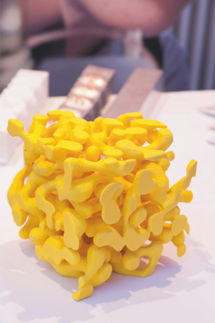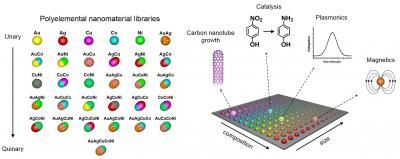A new window into the deformation of nanoscale materials
Materials on the nanoscale don't always have the same properties they would in bulk; for one thing, nanomaterials are often a lot harder. Unlike most bulk materials, a crystal that is small enough can be perfect, free of defects, capable of achieving strength near its ideal theoretical limit. Scientists have long assumed that a crystal needs to be perfect to sustain stress at its theoretical limit. Beyond this point dislocations in the crystal lattice occur, and the crystal undergoes a nonreversible change of shape, or plastic deformation.
Now a team from the Department of Energy's Lawrence Berkeley National Laboratory, Purdue University, and Hysitron Incorporated in Minneapolis has found that things don not necessarily happen this way. Using special instrumentation with the JEOL 3010 In Situ Transmission Electron Microscope at the National Center for Electron Microscopy (NCEM), the researchers were able to correlate high-resolution load-displacement measurements with individual video frames, showing how nanoscale volumes of aluminum deform under stress from a diamond "nanoindenter."
"Although it's been assumed that you need a perfect volume of material to reach the ideal strength, our results show this is not always true," says Andrew Minor of Berkeley Lab's Materials Sciences Division, who led the research team. "The situation is more complex. We found that plenty of defects accumulate before the point that would usually be interpreted as the initial yield point."
And that's not all, Minor adds. "Surprisingly, even when the material had a high defect density it could withstand near-theoretical shear stresses."
Team member Zhiwei Shan says, "Ideas about the onset of plasticity during nanoindentation have typically been based on indirect evidence. Computational studies can calculate the ideal strength of a material based on its electronic structure and the bond strengths between the atoms in a perfect crystal. While researchers have tried to correlate these calculated ideal strengths with nanoindentation experiments, until now they've had to infer the relationship after the fact, mainly from the strengths achieved."
The specially equipped in situ transmission electron microscope that revealed the true sequence of events, says Minor, "is an experimental set-up unique in the world" because it combines, for the first time, two distinct ways of looking at the onset of plasticity during nanoindentation, producing images of the deformation events and mechanical data at the same time.
Nanoindentation techniques pioneered at NCEM feature real-time movies, which can be studied frame by frame, taken inside the transmission electron microscope. Another way of studying plasticity is outside the microscope, with sensors that precisely measure the forces imposed by the indenter as the system evolves. "Until now, attempts to correlate deformation events with force measurements have been ex post facto and thus inherently limited," says Minor.
The research team built a quantitative in situ nanoindenter by integrating a capacitive force sensor from Hysitron into a sample holder designed by NCEM, taking advantage of the in situ microscope's large sample-stage area. For the first time data and movies documenting nanoscale deformation events could be made simultaneously and directly.
"Most people have the force-versus-displacement graph but not the movie," says Shan. "On the graph, one big spike marks the 'pop-in' event -- usually thought of as the onset of plasticity. In movies, the first appearance of defects and displacements was thought to be the pop-in event."
"As it turns out, these two events don't necessarily coincide," says Minor. "In fact there are often faint signals of deformation before the actual pop-in event in many nanoindentation data sets, but these subtleties have often been regarded as noise, or just assumed to be unimportant."
A typical nanoindentation experiment with the new set-up involves a three-sided diamond indenter approaching the apex of a target grain of aluminum, a single crystal within a thin film of aluminum deposited on a silicon substrate. As the indenter loads the crystal -- pressing against it -- the load and displacement of the indenter are plotted on a graph. Simultaneously the video shows corresponding changes in the crystal.
In the evolving graph of one such event, two small transients are observed that correspond to video frames showing the sudden appearance of dislocations in the crystal. In the first event, the apparently flawless crystal instantly becomes overcome with defects. In the second event, the defects abruptly shift. These changes show dislocations (line defects in the crystal) breaking free, gliding over other sections, interacting, and then coming to rest at their new equilibrium positions.
Remarkably, although consumed with dislocations, the crystal is enduring shear stresses nearly equal to the calculated ideal strength of the material. Pop-in is still to come.
When it does, the event is inescapable on both graph and video frame. The graph shows a sustained rise in force, then a sudden relaxation of load as the crystal gives way. The video frame shows a new pattern of defect contrast and a different geometry of the defect-riddled crystal grain.
Says Shan, "These results challenge the traditional concept of the initial deformation of crystalline materials. The discovery poses many new questions about other kinds of nanoscale materials, including thin films, nanowires, and individual nanoparticles. We're eagerly pursuing those questions now."
Minor says, "For the first time we can directly investigate fundamental parameters like elastic moduli and the stresses required to initiate dislocations and their movement, a prospect that has the materials science community very excited. It's opened up a new window into the world of nanomechanics."
Original publication: A. M. Minor, S. A. Syed Asif, Z. W. Shan, E. A. Stach, E. Cyranowski, T. J. Wyrobek, O. L. Warren; "A new view of the onset of plasticity during the nanoindentation of aluminum," Nature Materials 2006.
Other news from the department science
These products might interest you
Most read news
More news from our other portals
See the theme worlds for related content
Topic world Sensor technology
Sensor technology has revolutionized the chemical industry by providing accurate, timely and reliable data across a wide range of processes. From monitoring critical parameters in production lines to early detection of potential malfunctions or hazards, sensors are the silent sentinels that ensure quality, efficiency and safety.

Topic world Sensor technology
Sensor technology has revolutionized the chemical industry by providing accurate, timely and reliable data across a wide range of processes. From monitoring critical parameters in production lines to early detection of potential malfunctions or hazards, sensors are the silent sentinels that ensure quality, efficiency and safety.






























































